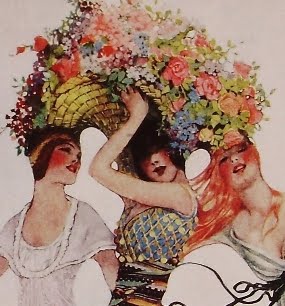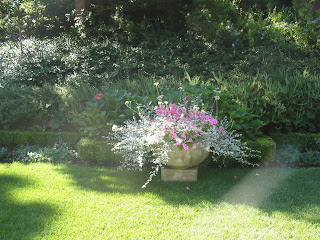I continually refer to symbolic archetypes as I embark upon a new garden design. Archetypes, for me, have always been such primordial and ubiquitous forces. I enter a place, especially a new place, and I become affected by one archetype or another. Often, when I enter a client’s space for the first time, I feel the presence of certain archetypes, and I feel driven to add others. I describe this to clients by suggesting the unfolding of a story or the creation of garden rooms. But because the garden has been a place within which I have grown up and spent so much of my time, I read each in terms of archetypes.
As used by early Greek and Roman philosophers, the term archetype was defined as origin or model. Similarly, the pre-Socratics referred to the archai as the fundamental building blocks of human life. Throughout his writings, psychologist Carl Jung used the term “archetype” as an inherited idea or mode of thought that is derived from the experience of the society and is present in the unconscious of the individual. Archetypes, thus, describe the patterns which lie at the depths of our being both individually and as a society, and so in turn shape how we experience our environments. However we wish to define this phenomena, with some slight convincing, I believe that we can all agree upon its occurrence.
Furthermore, archetype is a universal theme that manifests itself differently on an individual basis. To state it another way, there are a few basic archetypes or patterns which exist at the unconscious level, but there are an infinite variety of specific images which point back to these few patterns. Further, if we believe these premises, we can agree that we are born with these patterns which structure our imagination and make it distinctly human. These archetypes are our instinctive symbols by which we relate to the world.
I once conducted a study of San Francisco’s Chinatown in terms of archetypes. The following is a condensed version.
Through inclusion of archetype, a place can relate to origin, and thus allow a glimpse of the source of our own thoughts and feelings. Because a place can be experienced through these same archetypes. It is here desired to view Chinatown through this filter of archetype. Through analysis of a place’s archetypical vocabulary, we begin to understand how a place can relate to origin, and thus allow a glimpse of the source of our own thoughts and feelings through our reaction, experience and understanding of the place. And it is, I believe, in this relation to origin that we feel comfortable, safe, and stimulated in a place.
The following will illustrate in both text and photos the several archetypes which are particularly evident in Chinatown:
• possession
• boundary
• perch
• art
• metaphor
• incident
• museum
POSSESSION
Possession encompasses the obvious—a sense of belonging, but it extends to a freedom of movement, a freedom of static, leisure, markings, and openness. In a world of given definitions and delineations, possession allows one to step beyond the boundaries.

In this Chinatown park, possession is taken in the naming of place, and in the depicting of images which reflect the character of the citizenry.

Again, images are depicted. Possession is also captured in the freedom to openly expose the banalities of the everyday.
BOUNDARY
Boundary complements possession, allowing a sense of arrival and a feeling of belonging. The sense of what is here as separate from what is there defines a place.

Perhaps nothing signals a sense of arrival as effectively as a gateway.
PERCH
The concept of perch extends back to a time when the perch literally allowed for human survival. Perch continues to elicit a sense of safety and well-being.

Here the perch archetype is observed at a sacred place.

Colorful perches look out above markets below.
ART
Emily Dickinson wrote “Nature is a haunted house, but art a house that wants to be haunted.” Compare this to ordinary life and culture: nature is an enchanted place, while human culture is an effort to evoke and sustain enchantment. The arts, thus, allow us to reflect upon our experiences and in so doing, invite soul into view. The soul is always searching for itself, and it receives great pleasure when it finds itself reflected in the surrounding environment.

Details charm and fascinate the soul of the passerby.

Movement and undulation offer artistic contemplation.

Art is evoked in the detailing of the columns.
INCIDENT
Incident serves to awaken. Tower, belfry, silhouette, vivid color, etc. entrap the eye so that it does not slide out infinitely to boredom. The skillful location of incident gives point to the basic shapes of the street or place, a sort of nudge. The pattern is there, but in the preoccupation of the everyday, our attention must be drawn to it.

An exclamation at the corner of this building serves as a comma to give pause.

Here, punctuation awakens the awareness.
METAPHOR
Metaphor extracts meaning at the suggestion that “this is that.” In this suggestion the imagination is awakened in the comparison.

This bank reflects a palatial metaphor.
MUSEUM
Above all, museums are palaces of memory, and in such a place, the most important activity to occur is simple, quiet, prolonged, and undisturbed meditation. We can observe that a museum is an important element in a city or town. It is important for the citizens to recall, and it is important for visitors to hear the message. Likewise, we can see that a museum extends beyond the physical building. We each build our own small museums—a collection of old love letters, grandma’s antique armoire, grandpa’s old hunting jacket, our child’s first lock of cut hair, a photo album. In thinking about the museum in such terms we can, thus, understand our deep connection with this archetype.

The museum archetype is in evidence in this barber shop window. The photo album displayed in the window testifies to past satisfied customers, friends, and happy events.

This carved stone memorial transforms Portsmouth Square into a museum by its inclusion. It marks the site as the location of the first public school in California.

Museum reflects the passage of time. This building clearly testifies to its memory of the passage of time. Without judgment, it is a living, or perhaps dying, museum.

Here, the building, itself, remains as a museum.
In summary, perhaps the best way to query my postulates would be to go out and seek them. I’d like to request that you ask yourself a few questions when you do so. Are you able to find archetypes? If so, do they help you to understand a place better? Do you find an abundance of archetypes in places which you feel comfortable in? Do you feel that a place void of archetypes is uncomfortable? In comparison of one place’s archetypes to another, do you find similar archetypes exist in each, yet manifested differently?
Perhaps I will soon traverse through one of my gardens and offer a similar photo journal of archetypes. This has, for me, been a refreshing reminder of the importance of archetypes driving good design.



























































